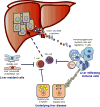Tumor regulation of the tissue environment in the liver
- PMID: 28167218
- PMCID: PMC5408316
- DOI: 10.1016/j.pharmthera.2017.02.005
Tumor regulation of the tissue environment in the liver
Abstract
The tumor microenvironment (TME) in the liver plays an important role in primary and metastatic liver tumor formation and tumor growth promotion. Cellular and non-cellular components of the TME significantly influence tumor development, growth, metastatic spread, anti-tumor immunity and response to tumor therapy. The cellular components of the TME in the liver not only consist of infiltrating immune cells, but also of liver-resident cells such as liver sinusoidal endothelial cells (LSEC) and hepatic stellate cells (HSC), which promote tumor growth by negatively regulating tumor-associated immune responses. In this review, we characterize cells of the TME with pro- and anti-tumor function in primary and metastatic liver tumors. Furthermore, we summarize mechanisms that permit growth of hepatic tumors despite the occurrence of spontaneous anti-tumor immune responses and how novel therapeutic approaches targeting the TME could unleash tumor-specific immune responses to improve survival of liver cancer patients.
Keywords: Hepatocellular carcinoma; Immunotherapy; Liver immunology; Liver metastases; Tumor immunology; Tumor microenvironment.
Published by Elsevier Inc.
Conflict of interest statement
The authors declare that there are no conflicts of interest.
Figures



Similar articles
-
CXCL12+ tumor-associated endothelial cells promote immune resistance in hepatocellular carcinoma.J Hepatol. 2025 Apr;82(4):634-648. doi: 10.1016/j.jhep.2024.09.044. Epub 2024 Oct 9. J Hepatol. 2025. PMID: 39393439
-
Deciphering the possible reciprocal loop between hepatic stellate cells and cancer cells in the tumor microenvironment of the liver.Crit Rev Oncol Hematol. 2023 Feb;182:103902. doi: 10.1016/j.critrevonc.2022.103902. Epub 2023 Jan 5. Crit Rev Oncol Hematol. 2023. PMID: 36621514 Review.
-
Nano delivery of simvastatin targets liver sinusoidal endothelial cells to remodel tumor microenvironment for hepatocellular carcinoma.J Nanobiotechnology. 2022 Jan 4;20(1):9. doi: 10.1186/s12951-021-01205-8. J Nanobiotechnology. 2022. PMID: 34983554 Free PMC article.
-
Cancer Stem Cell and Hepatic Stellate Cells in Hepatocellular Carcinoma.Technol Cancer Res Treat. 2023 Jan-Dec;22:15330338231163677. doi: 10.1177/15330338231163677. Technol Cancer Res Treat. 2023. PMID: 36938618 Free PMC article. Review.
-
Targeting monocyte-intrinsic enhancer reprogramming improves immunotherapy efficacy in hepatocellular carcinoma.Gut. 2020 Feb;69(2):365-379. doi: 10.1136/gutjnl-2018-317257. Epub 2019 May 10. Gut. 2020. PMID: 31076403
Cited by
-
An update on the role of complement in hepatocellular carcinoma.Front Immunol. 2022 Oct 19;13:1007382. doi: 10.3389/fimmu.2022.1007382. eCollection 2022. Front Immunol. 2022. PMID: 36341431 Free PMC article. Review.
-
HIF-1α expression in liver metastasis but not primary colorectal cancer is associated with prognosis of patients with colorectal liver metastasis.World J Surg Oncol. 2020 Sep 7;18(1):241. doi: 10.1186/s12957-020-02012-5. World J Surg Oncol. 2020. PMID: 32895059 Free PMC article.
-
The inhibitory effect of TU-100 on hepatic stellate cell activation in the tumor microenvironment.Oncotarget. 2020 Dec 8;11(49):4593-4604. doi: 10.18632/oncotarget.27835. eCollection 2020 Dec 8. Oncotarget. 2020. PMID: 33346211 Free PMC article.
-
An immune-related biomarker index for predicting the effectiveness of immunotherapy and prognosis in hepatocellular carcinoma.J Cancer Res Clin Oncol. 2023 Sep;149(12):10319-10333. doi: 10.1007/s00432-023-04899-5. Epub 2023 Jun 5. J Cancer Res Clin Oncol. 2023. PMID: 37273105 Free PMC article.
-
A comprehensive review about the utilization of immune checkpoint inhibitors and combination therapy in hepatocellular carcinoma: an updated review.Cancer Cell Int. 2022 Aug 23;22(1):269. doi: 10.1186/s12935-022-02682-z. Cancer Cell Int. 2022. PMID: 35999569 Free PMC article. Review.
References
-
- Ali MY, Grimm CF, Ritter M, Mohr L, Allgaier HP, Weth R, Bocher WO, Endrulat K, Blum HE, Geissler M. Activation of dendritic cells by local ablation of hepatocellular carcinoma. J Hepatol. 2005;43:817–822. - PubMed
-
- Arteta B, Lasuen N, Lopategi A, Sveinbjornsson B, Smedsrod B, Vidal-Vanaclocha F. Colon carcinoma cell interaction with liver sinusoidal endothelium inhibits organ-specific antitumor immunity through interleukin-1-induced mannose receptor in mice. Hepatology. 2010;51:2172–2182. - PubMed
-
- Berg M, Wingender G, Djandji D, Hegenbarth S, Momburg F, Hammerling G, Limmer A, Knolle P. Cross-presentation of antigens from apoptotic tumor cells by liver sinusoidal endothelial cells leads to tumor-specific CD8+ T cell tolerance. Eur J Immunol. 2006;36:2960–2970. - PubMed
-
- Bilate AM, Lafaille JJ. Induced CD4+Foxp3+ regulatory T cells in immune tolerance. Annu Rev Immunol. 2012;30:733–758. - PubMed
Publication types
MeSH terms
Grants and funding
LinkOut - more resources
Full Text Sources
Other Literature Sources
Medical

